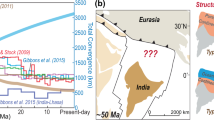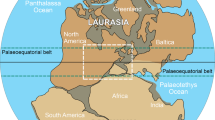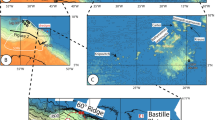Abstract
Convergence between the Indian and Asian plates has reshaped large parts of Asia, changing regional climate and biodiversity, yet geodynamic models fundamentally diverge on how convergence was accommodated since the India–Asia collision. Here we report palaeomagnetic data from the Burma Terrane, which is at the eastern edge of the collision zone and is famous for its Cretaceous amber biota, to better determine the evolution of the India–Asia collision. The Burma Terrane was part of a Trans-Tethyan island arc and stood at a near-equatorial southern latitude at ~95 Ma, suggesting island endemism for the Burmese amber biota. The Burma Terrane underwent significant clockwise rotation between ~80 and 50 Ma, causing its subduction margin to become hyper-oblique. Subsequently, it was translated northward on the Indian Plate by an exceptional distance of at least 2,000 km along a dextral strike-slip fault system in the east. Our reconstructions are only compatible with geodynamic models involving an initial collision of India with a near-equatorial Trans-Tethyan subduction system at ~60 Ma, followed by a later collision with the Asian margin.
This is a preview of subscription content, access via your institution
Access options
Access Nature and 54 other Nature Portfolio journals
Get Nature+, our best-value online-access subscription
$29.99 / 30 days
cancel any time
Subscribe to this journal
Receive 12 print issues and online access
$259.00 per year
only $21.58 per issue
Buy this article
- Purchase on Springer Link
- Instant access to full article PDF
Prices may be subject to local taxes which are calculated during checkout




Similar content being viewed by others
Data availability
The authors declare that all data supporting the findings of this study are available within the main article, its Supplementary Information, Supplementary Dataset 1 (palaeomagnetic mean directions), Supplementary Dataset 2 (palaeomagnetic data per sample) and Supplementary Dataset 3 (40Ar/39Ar data and parameters).
Change history
08 October 2019
An amendment to this paper has been published and can be accessed via a link at the top of the paper.
References
Molnar, P. & Tapponnier, P. Cenozoic tectonics of Asia: effects of a continental collision: features of recent continental tectonics in Asia can be interpreted as results of the India-Eurasia collision. Science 189, 419–426 (1975).
Aitchison, J. C., Ali, J. R. & Davis, A. M. When and where did India and Asia collide? J. Geophys. Res. 112, B05423 (2007).
Replumaz, A., Negredo, A. M., Guillot, S. & Villaseñor, A. Multiple episodes of continental subduction during India/Asia convergence: insight from seismic tomography and tectonic reconstruction. Tectonophysics 483, 125–134 (2010).
Ingalls, M., Rowley, D. B., Currie, B. & Colman, A. S. Large-scale subduction of continental crust implied by India–Asia mass-balance calculation. Nat. Geosci. 9, 848–853 (2016).
van Hinsbergen, D. J. J. et al. Reconstructing Greater India: Paleogeographic, kinematic, and geodynamic perspectives. Tectonophysics 760, 69–94 (2018).
Cogne, J.-P., Besse, J., Chen, Y. & Hankard, F. A new Late Cretaceous to present APWP for Asia and its implications for paleomagnetic shallow inclinations in central Asia and Cenozoic Eurasian plate deformation. Geophys. J. Int. 192, 1000–1024 (2013).
Hu, X. et al. The timing of India-Asia collision onset – facts, theories, controversies. Earth Sci. Rev. 160, 264–299 (2016).
Jagoutz, O., Royden, L., Holt, A. F. & Becker, T. W. Anomalously fast convergence of India and Eurasia caused by double subduction. Nat. Geosci. 8, 475–478 (2015).
Replumaz, A., Guillot, S., Villaseñor, A. & Negredo, A. M. Amount of Asian lithospheric mantle subducted during the India/Asia collision. Gondwana Res. 24, 936–945 (2013).
Royden, L. H., Burchfiel, B. C. & van der Hilst, R. D. The geological evolution of the Tibetan plateau. Science 321, 1054–1058 (2008).
Tapponnier, P., Peltzer, G., Le Dain, A. Y., Armijo, R. & Cobbold, P. Propagating extrusion tectonics in Asia: new insights from simple experiments with plasticine. Geology 10, 611–616 (1982).
Van Hinsbergen, D. J. et al. Greater India basin hypothesis and a two-stage Cenozoic collision between India and Asia. Proc. Natl Acad. Sci. USA 109, 7659–7664 (2012).
Zahirovic, S., Seton, M. & Müller, R. D. The Cretaceous and Cenozoic tectonic evolution of southeast Asia. Solid Earth 5, 227–273 (2014).
Dupont-Nivet, G., Lippert, P. C., Van Hinsbergen, D. J. J., Meijers, M. J. M. & Kapp, P. Palaeolatitude and age of the Indo-Asia collision: palaeomagnetic constraints: palaeolatitude and age of the Indo-Asia collision. Geophys. J. Int 182, 1189–1198 (2010).
van Hinsbergen, D. J. J. et al. Restoration of Cenozoic deformation in Asia and the size of Greater India. Tectonics 30, TC5003 (2011).
Gibbons, A. D., Zahirovic, S., Müller, R. D., Whittaker, J. M. & Yatheesh, V. A tectonic model reconciling evidence for the collisions between India, Eurasia and intra-oceanic arcs of the central-eastern Tethys. Gondwana Res. 28, 451–492 (2015).
Hall, R. Late Jurassic–Cenozoic reconstructions of the Indonesian region and the Indian Ocean. Tectonophysics 570–571, 1–41 (2012).
Poinar, G. Jr. Burmese amber: evidence of Gondwanan origin and Cretaceous dispersion. Hist. Biol. https://doi.org/10.1080/08912963.2018.1446531 (2018).
Grimaldi, D. A., Engel, M. S. & Nascimbene, P. C. Fossiliferous Cretaceous Amber from Myanmar (Burma): Its Rediscovery, Biotic Diversity, and Paleontological Significance American Museum Novitates No. 3361 (American Museum of Natural History, 2002).
Licht, A. et al. Asian monsoons in a late Eocene greenhouse world. Nature 513, 501–506 (2014).
Licht, A. et al. Paleogene evolution of the Burmese forearc basin and implications for the history of India-Asia convergence. Geol. Soc. Am. Bull. 131, 730–748 (2018).
Socquet, A. et al. India and Sunda plates motion and deformation along their boundary in Myanmar determined by GPS. J. Geophys. Res. Solid Earth 111, B05406 (2006).
Barber, A. J. & Crow, M. J. Structure of Sumatra and its implications for the tectonic assembly of southeast Asia and the destruction of Paleotethys. Isl. Arc 18, 3–20 (2009).
Mitchell, A., Chung, S.-L., Oo, T., Lin, T.-H. & Hung, C.-H. Zircon U–Pb ages in Myanmar: magmatic–metamorphic events and the closure of a neo-Tethys ocean? J. Asian Earth Sci. 56, 1–23 (2012).
Liu, C.-Z. et al. Tethyan suturing in southeast Asia: zircon U-Pb and Hf-O isotopic constraints from Myanmar ophiolites. Geology 44, 311–314 (2016).
Searle, M. P. et al. Chapter 12 Tectonic and metamorphic evolution of the Mogok metamorphic and Jade Mines belts and ophiolitic terranes of Burma (Myanmar). Geol. Soc. Lond. Mem. 48, 261–293 (2017).
Zhang, P. et al. Structures, uplift, and magmatism of the western Myanmar arc: constraints to mid-Cretaceous-Paleogene tectonic evolution of the western Myanmar continental margin. Gondwana Res. 52, 18–38 (2017).
Fareeduddin, A. & Dilek, Y. Structure and petrology of the Nagaland-Manipur Hill Ophiolitic Mélange zone, NE India: A fossil Tethyan subduction channel at the India-Burma plate boundary. Episodes 38, 298–314 (2015).
Zhang, J. et al. Multiple alternating forearc- and backarc-ward migration of magmatism in the Indo-Myanmar orogenic belt since the Jurassic: documentation of the orogenic architecture of eastern Neotethys in SE Asia. Earth Sci. Rev. 185, 704–731 (2018).
Mitchell, A. H. G. Cretaceous–Cenozoic tectonic events in the western Myanmar (Burma)–Assam region. J. Geol. Soc. London 150, 1089–1102 (1993).
Morley, C. K. Syn-kinematic sedimentation at a releasing splay in the northern Minwun Ranges, Sagaing fault zone, Myanmar: significance for fault timing and displacement. Basin Res. 29, 684–700 (2017).
Morley, C. K. & Arboit, F. Dating the onset of motion on the Sagaing Fault: evidence from detrital zircon and titanite U-Pb geochronology from the north Minwun basin, Myanmar. Geology 47, 581–585 (2019).
Bertrand, G. & Rangin, C. Tectonics of the western margin of the Shan plateau (central Myanmar): implication for the India–Indochina oblique convergence since the Oligocene. J. Asian Earth Sci. 21, 1139–1157 (2003).
Morley, C. K. Chapter 4 Cenozoic rifting, passive margin development and strike-slip faulting in the Andaman Sea: a discussion of established v. new tectonic models. Geol. Soc. Lond. Mem. 47, 27–50 (2017).
Morley, C. K. Nested strike-slip duplexes, and other evidence for Late Cretaceous–Palaeogene transpressional tectonics before and during India–Eurasia collision, in Thailand, Myanmar and Malaysia. J. Geol. Soc. London 161, 799–812 (2004).
Yao, W. et al. Origin and tectonic evolution of Upper Triassic turbidites in the Indo-Burman ranges, West Myanmar. Tectonophysics 721, 90–105 (2017).
Sevastjanova, I. et al. Myanmar and Asia united, Australia left behind long ago. Gondwana Res. 32, 24–40 (2016).
Pivnik, D. A. et al. Polyphase deformation in a fore-arc/back-arc basin, Salin subbasin, Myanmar (Burma). Am. Assoc. Pet. Geol. Bull. 82, 1837–1856 (1998).
Gardiner, N. J. et al. Contrasting granite metallogeny through the zircon record: a case study from Myanmar. Sci. Rep. 7, 748 (2017).
Wang, J.-G., Wu, F.-Y., Tan, X.-C. & Liu, C.-Z. Magmatic evolution of the western Myanmar arc documented by U–Pb and Hf isotopes in detrital zircon. Tectonophysics 612–613, 97–105 (2014).
Singh, A. K. et al. Evidence of mid-ocean ridge and shallow subduction forearc magmatism in the Nagaland-Manipur ophiolites, northeast India: constraints from mineralogy and geochemistry of gabbros and associated mafic dykes. Geochemistry 76, 605–620 (2016).
Torsvik, T. H. et al. Phanerozoic polar wander, palaeogeography and dynamics. Earth Sci. Rev. 114, 325–368 (2012).
Arason, P. & Levi, S. Models of inclination shallowing during sediment compaction. J. Geophys. Res. 95, 4481–4499 (1990).
Zaman, H. & Torii, M. Palaeomagnetic study of Cretaceous red beds from the eastern Hindukush Ranges, northern Pakistan: palaeoreconstruction of the Kohistan-Karakoram composite unit before the India-Asia collision. Geophys. J. Int. 136, 719–738 (1999).
Rangin, C., Maurin, T. & Masson, F. Combined effects of Eurasia/Sunda oblique convergence and East-Tibetan crustal flow on the active tectonics of Burma. J. Asian Earth Sci. 76, 185–194 (2013).
Leloup, P. H., Tapponnier, P., Lacassin, R. & Searle, M. P. Discussion on the role of the Red River shear zone, Yunnan and Vietnam, in the continental extrusion of SE Asia. J. Geol. Soc. London 164, 1253–1260 (2007).
Li, S., van Hinsbergen, D. J. J., Deng, C., Advokaat, E. L. & Zhu, R. Paleomagnetic constraints from the Baoshan area on the deformation of the Qiangtang-Sibumasu terrane around the eastern Himalayan syntaxis. J. Geophys. Res. Solid Earth 123, 977–997 (2018).
Tong, Y.-B. et al. Internal crustal deformation in the northern part of Shan-Thai block: new evidence from paleomagnetic results of Cretaceous and Paleogene redbeds. Tectonophysics 608, 1138–1158 (2013).
Wang, Y. et al. Kinematics and 40Ar/39Ar geochronology of the Gaoligong and Chongshan shear systems, western Yunnan, China: implications for early Oligocene tectonic extrusion of SE Asia. Tectonophysics 418, 235–254 (2006).
Evans, D., Müller, W., Oron, S. & Renema, W. Eocene seasonality and seawater alkaline earth reconstruction using shallow-dwelling large benthic foraminifera. Earth Planet. Sci. Lett. 381, 104–115 (2013).
Müller, R. D. et al. GPlates: building a virtual Earth through deep time. Geochem. Geophys. Geosyst. 19, 2243–2261 (2018).
Roperch, P. & Taylor, G. K. The importance of gyromagnetic remanence in alternating field demagnetization. Some new data and experiments on GRM and RRM. Geophys. J. Int. 87, 949–965 (1986).
Kirschvink, J. L. The least-squares line and plane and the analysis of palaeomagnetic data. Geophys. J. Int. 62, 699–718 (1980).
McFadden, P. L. & McElhinny, M. The combined analysis of remagnetisation circles and direct observation in palaeomagnetism. Earth Planet. Sci. Lett. 87, 161–172 (1988).
Butler, R. F. Paleomagnetism: Magnetic Domains to Geologic Terranes (Blackwell Scientific Publications, 1992).
Fisher, R. Dispersion on a sphere. Proc. R. Soc. Lond. A 217, 295–305 (1953).
Tauxe, L. & Watson, G. S. The fold test: an eigen analysis approach. Earth Planet. Sci. Lett. 122, 331–341 (1994).
Tauxe, L. Essentials of Paleomagnetism (University of California Press, 2010).
King, R. F. The remanent magnetism of artificially deposited sediments. Geophys. J. Int. 7, 115–134 (1955).
Tauxe, L. & Kent, D. V. in Timescales of the Geophysical Field, Geophysical Monograph Vol. 145 (ed. Channell, J.) 101–116 (American Geophysical Union, 2004).
Tauxe, L., Kodama, K. P. & Kent, D. V. Testing corrections for paleomagnetic inclination error in sedimentary rocks: a comparative approach. Phys. Earth Planet. In. 169, 152–165 (2008).
Cogné, J.-P. Contribution a l’Étude Paléomagnétique des Roches Déformées. Doctorat d'Etat thesis, Université Rennes 1 (1987).
Renne, P. R. et al. Intercalibration of standards, absolute ages and uncertainties in 40Ar/39Ar dating. Chem. Geol. 145, 117–152 (1998).
Renne, P. R., Mundil, R., Balco, G., Min, K. & Ludwig, K. R. Joint determination of 40K decay constants and 40Ar∗/40K for the Fish Canyon sanidine standard, and improved accuracy for 40Ar/39Ar geochronology. Geochim. Cosmochim. Acta 74, 5349–5367 (2010).
Renne, P. R., Balco, G., Ludwig, K. R., Mundil, R. & Min, K. Response to the comment by W.H. Schwarz et al. on “Joint determination of 40K decay constants and 40Ar∗/40K for the Fish Canyon sanidine standard, and improved accuracy for 40Ar/39Ar geochronology” by P.R. Renne et al. (2010). Geochim. Cosmochim. Acta 75, 5097–5100 (2011).
Matthews, K. J. et al. Global plate boundary evolution and kinematics since the late Paleozoic. Glob. Planet. Change 146, 226–250 (2016).
Advokaat, E. L. et al. Cenozoic rotation history of Borneo and Sundaland, SE asia revealed by paleomagnetism, seismic tomography, and kinematic reconstruction. Tectonics 37, 2486–2512 (2018).
Li, S. et al. Paleomagnetic constraints on the Mesozoic-Cenozoic paleolatitudinal and rotational history of Indochina and South China: review and updated kinematic reconstruction. Earth Sci. Rev. 171, 58–77 (2017).
Torsvik, T. H., Müller, R. D., Van der Voo, R., Steinberger, B. & Gaina, C. Global plate motion frames: toward a unified model. Rev. Geophys. 46, RG3004 (2008).
Acknowledgements
This research was primarily funded by the European Reseach Council’s consolidator grant MAGIC (Monsoons in Asia caused Greenhouse to Icehouse Cooling) no. 649081 to G.D.-N. We thank C. Kissel for the use of the AGM magnetometer at the Laboratoire des Sciences du Climat et de l’Environnement’s palaeomagnetic laboratory, France. Furthermore, we thank L. Joanny and F. Gouttefangeas for their help with scanning electron microscope data acquisition. We are grateful to P. Cullerier and A. Bernard for their help in the laboratory. We thank E. Advokaat, F. Fluteau, S. Guillot, E. Hallot, C. Rangin, A. Replumaz, M. Searle and D. van Hinsbergen for prolific discussions in the course of this study. Finally, we are grateful to C. Morley, R. Hall and J. Geissman for their constructive comments, which helped to clarify our data presentation and model.
Author information
Authors and Affiliations
Contributions
P.R., A.L. and G.D.-N. conceived the project. J.W., P.R., A.L., G.D.-N., Z.W., F.P., H.H.S., M.K.T. and D.W.A. participated in the sampling. J.W. and P.R. performed the palaeomagnetic analysis. G.R. performed the radiometric analysis. J.W., P.R. and F.B. built the GPlates model. J.W., P.R., A.L. and G.D.-N. wrote the manuscript with contributions from other authors.
Corresponding author
Ethics declarations
Competing interests
The authors declare no competing interests.
Additional information
Publisher’s note: Springer Nature remains neutral with regard to jurisdictional claims in published maps and institutional affiliations.
Supplementary information
Supplementary Information
Burma Terrane geological setting and sampling localities, petrologic, 40Ar/39Ar and palaeomagnetic analyses and figures.
Supplementary Dataset 1
Palaeomagnetic mean directions from early Late Cretaceous and late Eocene. If available for a site, geochronological data from this or other studies are also displayed.
Supplementary Dataset 2
Individual palaeomagnetic samples used for calculating the mean directions. Type of demagnetization, demagnetization steps and the result in both in-situ and tilt-corrected coordinates with corresponding errors. All samples are listed by locality and site.
Supplementary Dataset 3
40Ar/39Ar results. Parameters used for calculations and reference sources.
Rights and permissions
About this article
Cite this article
Westerweel, J., Roperch, P., Licht, A. et al. Burma Terrane part of the Trans-Tethyan arc during collision with India according to palaeomagnetic data. Nat. Geosci. 12, 863–868 (2019). https://doi.org/10.1038/s41561-019-0443-2
Received:
Accepted:
Published:
Issue Date:
DOI: https://doi.org/10.1038/s41561-019-0443-2
This article is cited by
-
Cretaceous integrative stratigraphy, biotas, and paleogeographical evolution of the Qinghai-Tibetan Plateau and its surrounding areas
Science China Earth Sciences (2024)
-
Intra-Oceanic Subduction Termination and Reinitiation of the Eastern Neo-Tethys in Myanmar
Journal of Earth Science (2024)
-
Three new species of Elcanidae (Insecta: Orthoptera) from Myanmar amber and a discussion about phylogeny, ecology and evolutionary origin of Myanmar-amber Elcanidae
PalZ (2024)
-
Influence of multi-stage volcanic events on the Late Cretaceous-Paleogene reservoirs and its geological significance in the northern Central Myanmar Basin
Journal of Oceanology and Limnology (2024)
-
A new species of Cretaceoushormiops from the mid-Cretaceous amber of northern Myanmar (Arachnida: Scorpiones: Protoischnuridae)
PalZ (2024)



